Every Nation Schemes its Master Stroke: Spies! by SPI
When I moved to Urbana, Illinois in 1987 to start grad school, I left behind a lively game group in my home town in Ottawa, and I missed it.
Fortunately Urbana has its own thriving gaming community (or at least it did, 30 years ago), and it wasn’t long before I fell in with a group of students who also enjoyed gaming. We traded Amiga games, gathered around lab PCs to play Starflight, and got together on weekends to try more ambitious diversions. One of the highlights for me was SPI’s Spies!, a fascinating and historical game of life-and-death spycraft in the run-up to World War II.
Typical of SPI games of the era, it was both fun to play and educational, and it gave me a newfound appreciation for the complexities of politics in pre-war Europe, and the dangerous games of brinksmanship played out in public and behind the scenes. It also helped bring to life an historical era I didn’t have a whole lot of interest in, and sparked an interest in World War II that has lingered to this day. If you’ve got some friends or family members whom you’d like to interest in 20th Century European history, trust me, this game is the way to do it.
[Click the images for bigger versions.]
Spies! (SPI first edition, 1981)
Spies! was designed by Lenny Glynn and John Prados and released by SPI in 1981. Unlike the major board games of the era, Spies! doesn’t involve moving armies around a colorful board. The focus is in on individuals gathering resources; avoiding the Gestapo, Scotland Yard, or other security forces; and navigating dangerous environments to nab crucial secrets, as all around them Europe lurches closer and closer to all-out war. In some ways it’s reminiscent of Jim Dunnigan’s 1971 Avalon Hill game of international power politics, Origins of World War II, and in some ways it’s closer to a role playing game.
It can be played with as few as two players, and as many as five. Players represent Germany, Italy, Russia, France and Britain, and the secrets up for grabs include the atomic bomb, the Enigma machine, sophisticated electronics, and lots more. It covers 1933-1939; the winner is the player who has best protected her own secrets, while successfully gathering those of her enemies before war finally breaks out.
SPI usually did a great job packaging and selling their games, and Spies! is no exception. I wanted to play the first time saw the back of the box. Here’s the text that fired my imagination.
Europe, 1933.
Beneath the fragile peace, a net of intrigue stretches throughout the back alleys and dusky avenues of a continent’s glittering capitals. Through this baffling maze, fraught with the dangers of hostile police and double-dealing, a breed of solitary men and women pursue the closely guarded secrets of nations. Despite the ceaseless threat of capture and sudden death, these silent fugitives conduct their covert war — where stealth and cunning are weapons, and the warriors are…. SPIES !
Spies! is the exciting game of espionage and intrigue, where you guide the destinies of major European nations through the turbulent years of 1933-39. Two to five players – representing Germany, Italy, Russia, France and Britain — vie with one another to uncover the mysteries of the atomic bomb, the Enigma code device, sophisticated electronics, and other top secrets. Your spies move by rail, air, and sea throughout Europe, North Africa, and the Middle East in search of their quarry, constantly endangered by the security cordons of your opponents’ police and counterspies. Uncover an enemy secret, rush home to your capital — but don’t get caught ! The competition will be fast and furious, and everything depends on your… Spies!
Back Alleys! Dusky avenues! Silent fugitives! You know whoever wrote that text yearned to write spy novels. They probably would have been good at it.
I think part of what makes Spies! so appealing is the dynamic setting. Everyone is familiar with 1930s Europe, at least to some extent. You know the players, and what the stakes are. Boarding the Orient Express to Istanbul with a briefcase full of atomic secrets and the Gestapo in hot pursuit gets the pulse up in a way that invading a nameless province in a fantasy wargame doesn’t.
The sheer scope of the game is another big plus. Game play takes place across the whole of Europe and North Africa, from Belfast to Cairo, Casablanca to Moscow. I don’t know about you, but I can’t look at the interconnecting train lines and ports on the Spies! map without being reminded of countless spy movies. It’s certainly evocative of a dangerous era, anyway, and that’s not a bad thing for a board game.
For all its richness of setting, Spies! is easy to learn. There are two rulebooks, a 4-page Standard Rules which can be read in 15 minutes, and an only slightly longer Long Game Rulebook, which adds Action Points and Spy Havens. You can learn the game in under 30 minutes.
One of the most intriguing aspects of the core mechanic also gives Spies! its greatest replay value: the Event tiles. Each player begins with 10, including 7 unique to each country and 3 randomly drawn. These can be played or discarded at the beginning of each turn.
All 50 Event tiles for Spies! (click for a legible version)
The Event Tiles capture the significant events leading the continent (and the world) to War. They are things like:
British Commission New Type of Battleship
Hungary Presses a Claim to Rumanian Territory
German Arms Production Soars!
Rhineland Remilitarized!
Arab Riots in the Palestinian Mandate
Every tile has consequences. Some make your nation richer, or poorer, or do the same to your enemies. Most also generate Action chits that you can used to advance your agenda, or hinder your opponents. It’s not too hard to create your own tiles to add a little variety (or increased historical verisimilitude, if that’s what you’re into).
Some Event Tiles can only be played in specific years, many can be played in any year, in any order.
The result, of course, is that events don’t play out the way they did historically. Or maybe they do, I dunno. When the heck did Hungary presse a claim to a Rumanian territory? Which one was that? (See what I mean about the game being educational?)
Anyway, the game unfolds differently every time — sometimes very differently. Sometimes events follow history. Maybe? You’d have to be more of a European history nut than I am to know for sure. But I sure know the exact geopolitical landscape of the Eastern Mediterranean the night Bill stole the secrets of radar from under my nose, I can tell you that.
Spies! (TSR edition, 1984)
Spies! was a pretty big success for SPI. I know this in two ways. One, there are about a million copies for sale on eBay on any given day (I bought an unpunched copy for $32 last month). And if you’ve ever tried to get a copy of a rare SPI game on eBay, you know they sure as hell don’t sell for $32.
Second, when TSR took over SPI in 1982 (as Bob Byrne covered in his article Simulations Publications Inc: The TSR Incursion), they killed most of the game line. But they did reprint a small handful of the most popular titles — including Spies!, repackaged to appeal to younger gamers, in 1984.
Origins of World War II (Avalon Hill, 1971)
Spies! is a unique game of geopolitical intrigue, and I’ve never played another game like it. It wasn’t the best game SPI ever produced, but it’s one of my favorites, and it’s still worth playing today.
Our previous coverage of SPI and other 20th Century board games includes:
SPI’s Swords and Sorcery by John O’Neill (2012)
Unleash your inner Conan with Barbarian Kings by John O’Neill (2013)
Magic Realm Lives Again by Jeff Stehman (2013)
Titan by John O’Neill (2013)
Avalon Hill’s Elric Young Kingdoms Adventure Game by John O’Neill (2013)
Vampiric Legions Versus Noble Knights: Avalon Hill’s Dark Emperor by John O’Neill (2015)
Simulations Publications Inc: The TSR Incursion by Bob Byrne (2017)
Big Adventure, Tiny Dungeons: SPI’s DeathMaze Mini-game by Deven Atkinson (2018)
See all of our recent Games coverage here.
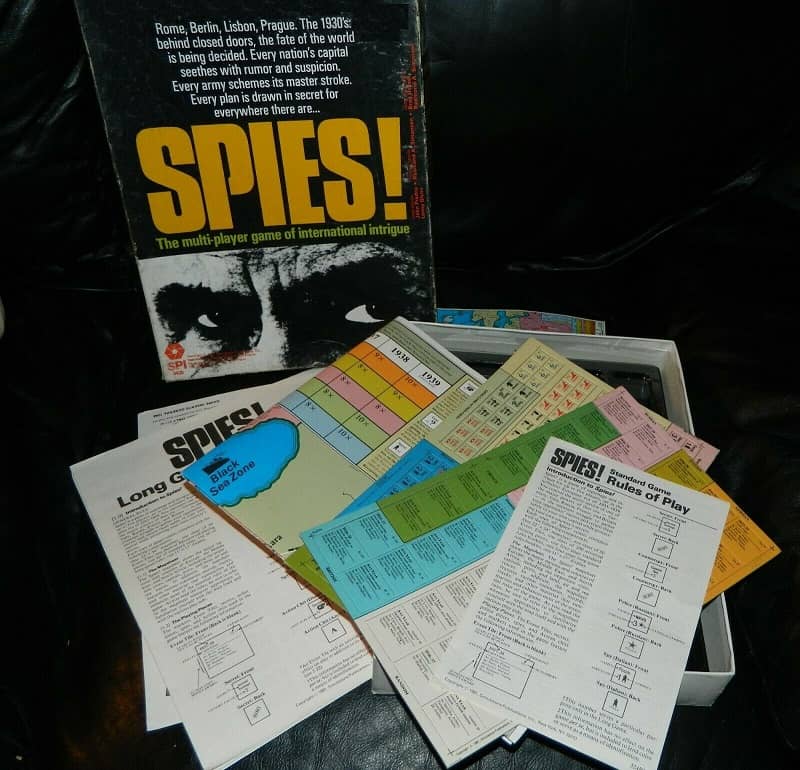
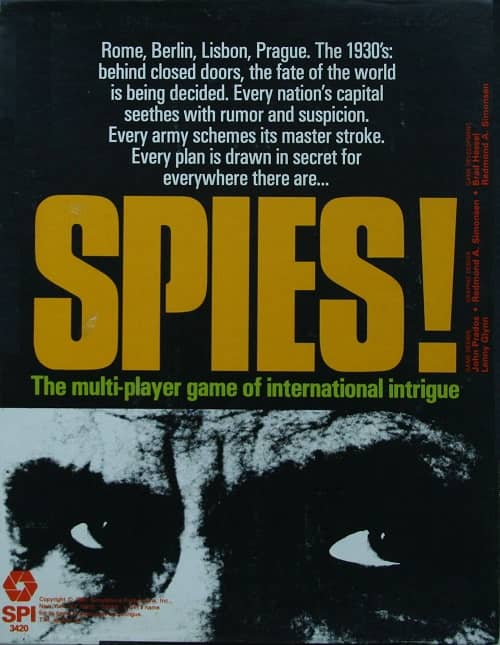
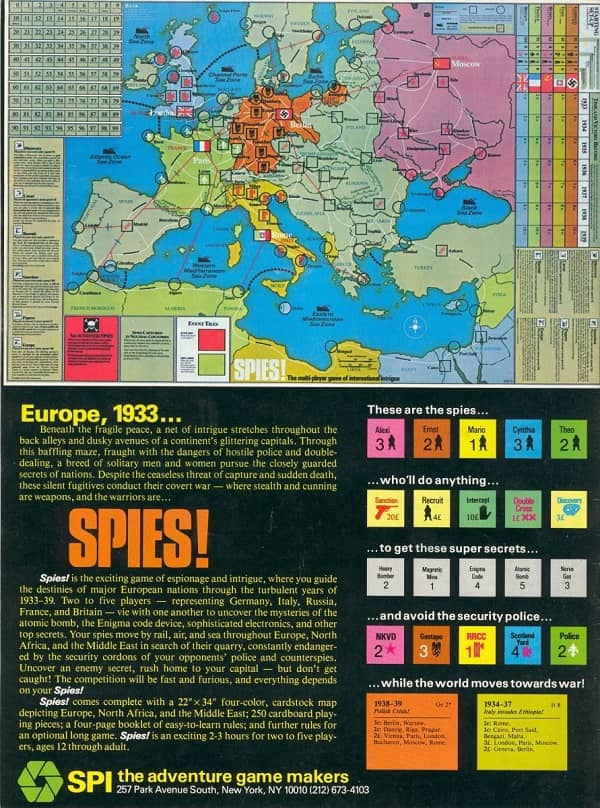
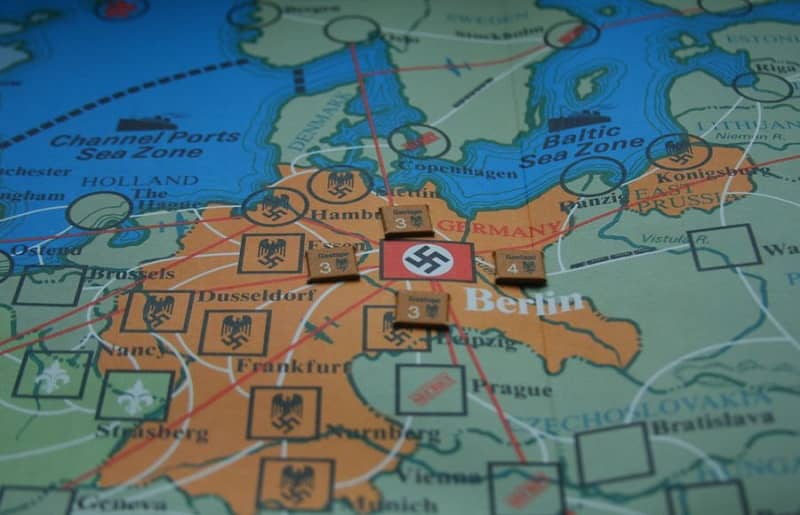
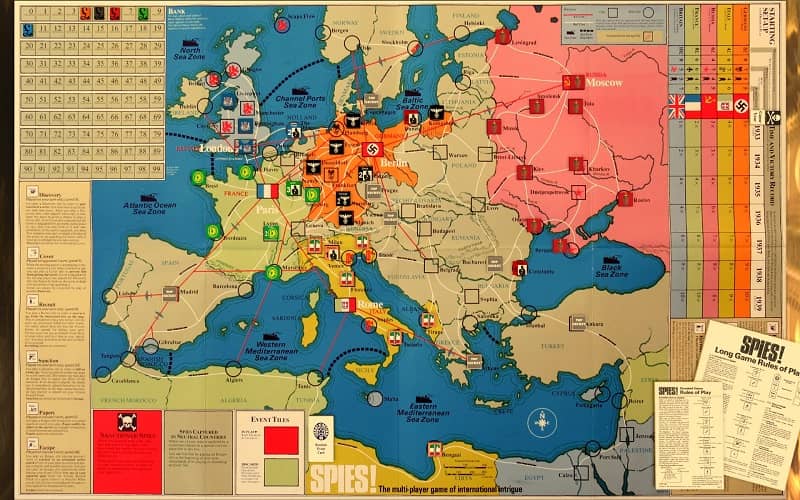
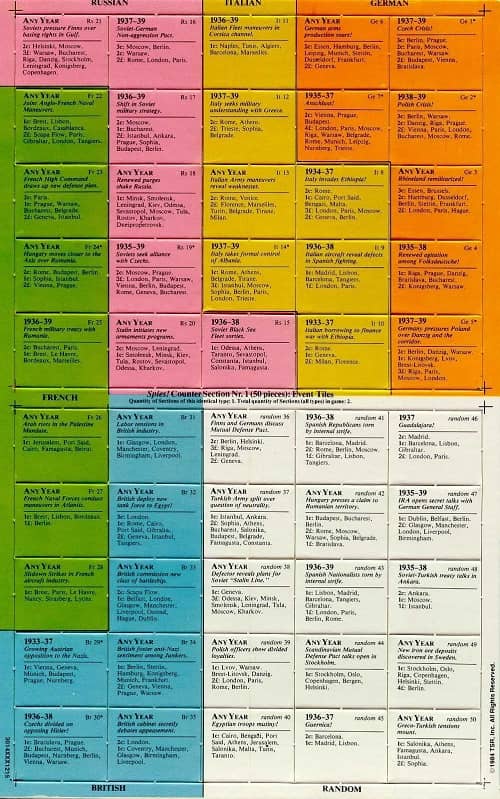
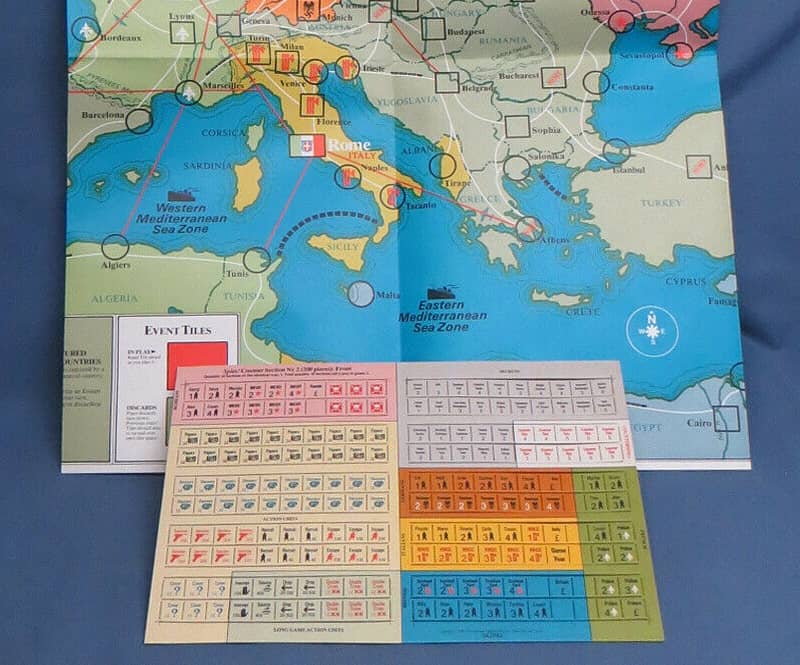
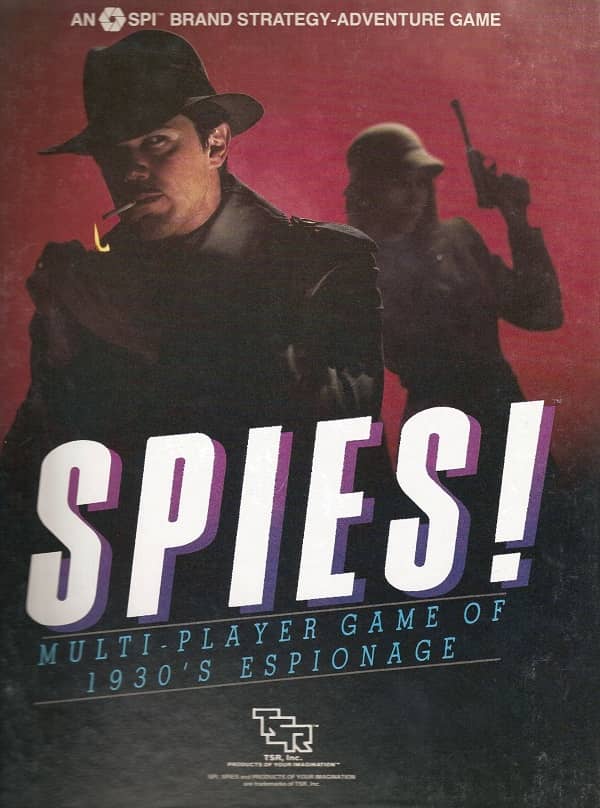
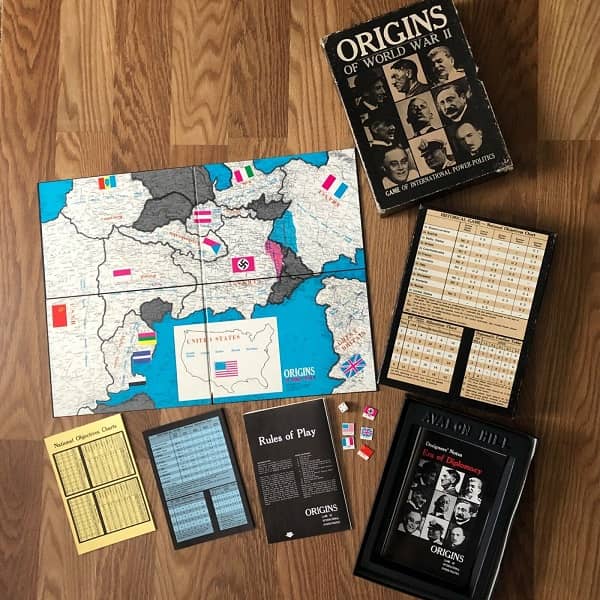
Now, there is a game I haven’t seen in a while.
It’s not talked about much any more, that’s for sure.
One of these days I’ll sell all my old SPI games and do something extravagant, like spend a day at Disneyland..which speaks both to how much you can get for some of these games, and how expensive Disneyland is!
Thomas,
LOL — indeed!
I don’t have much of an SPI game collection. I do have a (well played) copy of WAR OF THE RING, which is highly collectible these days, and most of their microgames. And a complete set of Ares magazine, of course.
But none of their famous World War II games, like War in the East, War in the Pacific, or Sniper!, which were their bread & butter. Those are the really expensive ones these days, too.
What have you got in your closet?
A couple years ago someone must have liquidated a bunch of old MetaGaming micro history series games. Because a ton of new copies showed up at Half Price Books.
John, do you have a copy of War of the Ring with the two smaller games Gondor and Sauron in the box?
Richard Berg just passed away late last year. He was active as a designer all the way up until the end.
> A couple years ago someone must have liquidated a bunch of old MetaGaming micro
> history series games. Because a ton of new copies showed up at Half Price Books.
Ah! I wish I’d seen that.
Half Price Books occasionally has some wonderful stuff — brand new British SF trades at rock bottom prices, new RPGs, vintage paperbacks, even old magazines. You never can tell what they’ll have in stock.
> John, do you have a copy of War of the Ring with the two smaller games Gondor and Sauron in the box?
I do! Though I never played them. They seemed like afterthoughts. I always thought they must have been magazine games from S&T, but I really don’t know where they came from.
My copy was a “flat pack” that looked like this:
The flat packs were cheap to produce, but terrible for actually sealing. Game pieces always fell out, and I was constantly finding them on the floor. It would be a miracle if my copy is still complete.
> Richard Berg just passed away late last year. He was active as a designer all the way up until the end.
Amazing! What else did he produce?
Way to many to list. BGG puts it at 192 games.
The big ones being Successors (1997), SPQR (1992), Men of Iron (2005), Hoplite (2014) co-designed with Mark Herman, and Pax Romana (2006)
I’m familiar with SPQR and Pax Romana, but not the others. I haven’t played historical wargames seriously in almost 25 years.
Do you still have the chance to play?
I’ve only bought a handful of modern wargames. I’ve only played one (Tide of Iron). The others like NO Retreat! and Fading Glory I’ve only had time to set them up and play a couple rounds.
John, I too have a War of the Ring – in pretty good shape, too. I have a lot of one-map SPI military games and quad game sets, plus several of the four map “monsters” – Terrible Swift Sword (Gettysburg), Atlantic Wall (D-Day), Wellington’s Victory (Waterloo), The Next War (hypothetical WWIII in Europe), Highway to the Reich (Operation Market-Garden), Drive on Stalingrad (the…uh…drive on Stalingrad) and a few more. If I remember correctly, a one map SPI was $12 new and the monsters were, I think, $40. Twenty years ago I sold my SPI Wacht Am Rhein (Battle of the Bulge), unpunched, for $400. That was way over value even then, but someone wanted it badly!
Every now and then I wonder why I keep these things. It’s highly unlikely I’ll ever again have the time/space/energy to play one of the big ones. But giving them up would be a final admission that I’m not seventeen any more…
Spies! is a wonderfully tense game that kept my college gaming group amused and at no risk of ever duplicating history. It was pretty notorious of our German players to trigger the war in 1938 with the “Early Invasion” tile. Usually just before my Cousin would be purloining whatever deep secret was hiding in Berlin. Ah, sigh for Spies!
> The big ones being Successors (1997), SPQR (1992), Men of Iron (2005),
> Hoplite (2014) co-designed with Mark Herman, and Pax Romana (2006)
Glenn,
That’s a heck of a list.
It’s funny — your comment sent me off to look at Roman-era wargames like SPQR and Pax Romana, and before long I had one in my Amazon cart. Oddly enough not one of Berg’s, but Z-Man’s Pandemic: Fall of Rome. No zombies, sadly, but barbarian hordes are almost as much fun to play as zombie hordes! (click the images for Rome-sized versions).
Berg (along with Mark Hermann) did a ton of ancient games for GMT using a system called GBOH (Great Battles of History). It’s a terrific model of ancient warfare, but it’s awfully “fiddly.” (A lot of constantly changing markers on top of markers on top of closely-packed units. But you’ll never have more fun recreating the Battle of Zama…)
> John, I too have a War of the Ring – in pretty good shape, too.
Thomas,
Did you have much opportunity to play? It was probably my favorite SPI fantasy game, but the setup (and teardown!) was so lengthy I can only remember playing it 2-3 times.
That’s what I remember about SPI (and Avalon Hill) games of the era. They were expertly produced, but boy, they required a commitment. It tooks hours to read the rules, and you needed a full day set aside to really play one.
Still, they were popular among the gaming groups in my home town in Ottawa in the late 70s and early 80s. Once they found a favorite, folks would play a game for years. They really did aim to produce games that could be enjoyed for many years.
> I have a lot of one-map SPI military games and quad game sets, plus
> several of the four map “monsters” – Terrible Swift Sword
> (Gettysburg), Atlantic Wall (D-Day), Wellington’s Victory (Waterloo), The Next War (hypothetical WWIII
> in Europe), Highway to the Reich (Operation Market-Garden), Drive
> on Stalingrad (the…uh…drive on Stalingrad) and a few more.
Oh man! I really wanted Atlantic Wall and (especially) The Next War. Still do. Of course, as you point out. they now sell for many hundreds of $$$ on eBay. They are always just out of reach! 🙂
I wonder if prices on these games will remain high? SPI gamers are aging rapidly — I was 18 when they effectively went out of business in 1982, and it seemed all the serious gamers I knew were older than me. But I suppose there are plenty of younger gamers who collect them as well these days.
> giving them up would be a final admission that I’m not seventeen any more…
I refuse to admit it! 🙂
> Spies! is a wonderfully tense game that kept my college gaming group amused and at no risk of ever duplicating history.
Eugene,
One of the things I should have mentioned in my review was that Spies! had a much broader appeal than the wargames we usually played. It pulled in a lot more casual gamers.
I guess it’s easier to relate to being a spy in pre-WWII Europe, especially compared with planning Operation Market Garden, or the other games we tried to drum up interest in!
> Berg (along with Mark Hermann) did a ton of ancient games for GMT using a system called GBOH
> (Great Battles of History). It’s a terrific model of ancient warfare, but it’s awfully “fiddly.”
Thomas,
I never bought any GMT games, and I think mostly for that reason. They had a rep for appealing to the grognards!
Delighted to stumble on this review of John Prados and my game, SPIES…lots of fun! Thanks
Lenny
Great to have you join us here Lenny!!
And thanks for the many hours of entertainment, all those years ago. 🙂
Any tidbits or anecdotes about the game or SPI you’d like to share with us?